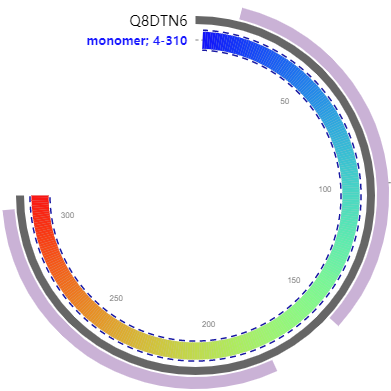Bifunctional enzyme which has both oligoribonuclease and pAp-phosphatase activities. Degrades short RNA and DNA oligonucleotides with a length of up to 33 nucleotides, although the enzyme is most active on shorter substrates, in a 5' to 3' direction. Converts 3'(2')-phosphoadenosine 5'-phosphate (PAP) to AMP, has very low activity on cAMP and cGMP. •
MTAFKTILAKIKAYDTIIIHRHMKPDPDALGSQVGLKEMITSNFPQKTVKVTGYNEPSLS
WLAQMDDVSDKDYEGALVIVVDTANRPRIDDQRYLNGNFLIKIDHHPDEDHYGDLSYVDT
KASSASEIITDFALQNQLKLSDQAARLLYAGILGDTGRFLYPATTSKTFIIASELLKYDF
DFAALARQMDSFPYKIAKLQAYVFENLEIDKNGAARIILSQKILKKFNLTDAETSAIVSS
PGKIDTVQVWAIFVEQADGHYRVRLRSKSTVINEVAKRHAGGGHPLASGANSYSLAENED
IYQELKNLLK315

| 17586819 | YtqI from Bacillus subtilis has both oligoribonuclease and pAp-phosphatase activity.Mechold U, Fang G, Ngo S, Ogryzko V, Danchin A | Oligoribonuclease is the only RNase in Escherichia coli that is able to degrade RNA oligonucleotides five residues and shorter in length. Firmicutes including Bacillus subtilis do not have an Oligoribonuclease (Orn) homologous protein and it is not yet understood which proteins accomplish the equivalent function in these organisms. We had previously identified oligoribonucleases Orn from E. coli and its human homolog Sfn in a screen for proteins that are regulated by 3'-phosphoadenosine 5'-phosphate (pAp). Here, we identify YtqI as a potential functional analog of Orn through its interaction with pAp. YtqI degrades RNA oligonucleotides in vitro with preference for 3-mers. In addition, YtqI has pAp-phosphatase activity in vitro. In agreement with these data, YtqI is able to complement both orn and cysQ mutants in E. coli. An ytqI mutant in B. subtilis shows impairment of growth in the absence of cysteine, a phenotype resembling that of a cysQ mutant in E. coli. Phylogenetic distribution of YtqI, Orn and CysQ supports bifunctionality of YtqI. | 2007 | |
| 0 | 21087930 | Role of RecJ-like protein with 5'-3' exonuclease activity in oligo(deoxy)nucleotide degradation.Wakamatsu T, Kim K, Uemura Y, Nakagawa N, Kuramitsu S, Masui R | RecJ-like proteins belonging to the DHH family have been proposed to function as oligoribonucleases and 3'-phosphoadenosine 5'-phosphate (pAp) phosphatases in bacteria and archaea, which do not have Orn (oligoribonuclease) and CysQ (pAp phosphatase) homologs. In this study, we analyzed the biochemical and physiological characterization of the RecJ-like protein TTHA0118 from Thermus thermophilus HB8. TTHA0118 had high enzymatic activity as an oligodeoxyribonucleotide- and oligoribonucleotide-specific exonuclease and as pAp phosphatase. The polarity of degradation was 5' to 3', in contrast to previous reports about Bacillus subtilis NrnA, a RecJ-like protein. TTHA0118 preferentially hydrolyzed short oligodeoxyribonucleotides and oligoribonucleotides, whereas the RecJ exonuclease from T. thermophilus HB8 showed no such length dependence on oligodeoxyribonucleotide substrates. An insertion mutation of the ttha0118 gene led to growth reduction in minimum essential medium. Added 5'-mononucleotides, nucleosides, and cysteine increased growth of the ttha0118 mutant in minimum essential medium. The RecJ-like protein Mpn140 from Mycoplasma pneumoniae M129, which cannot synthesize nucleic acid precursors de novo, showed similar biochemical features to TTHA0118. Furthermore, B. subtilis NrnA also hydrolyzed oligo(deoxy)ribonucleotides in a 5'-3' direction. These results suggested that these RecJ-like proteins act in recycling short oligonucleotides to mononucleotides and in controlling pAp concentrations in vivo. | 2011 |
Wakamatsu T , Kim K , Uemura Y , et al. Role of RecJ-like Protein with 5"-3" Exonuclease Activity in Oligo(deoxy)nucleotide Degradation[J]. Journal of Biological Chemistry, 2011, 286(4):2807-2816.